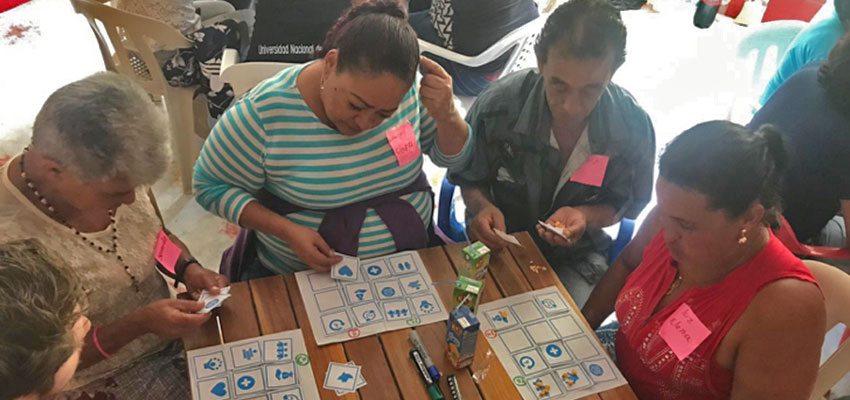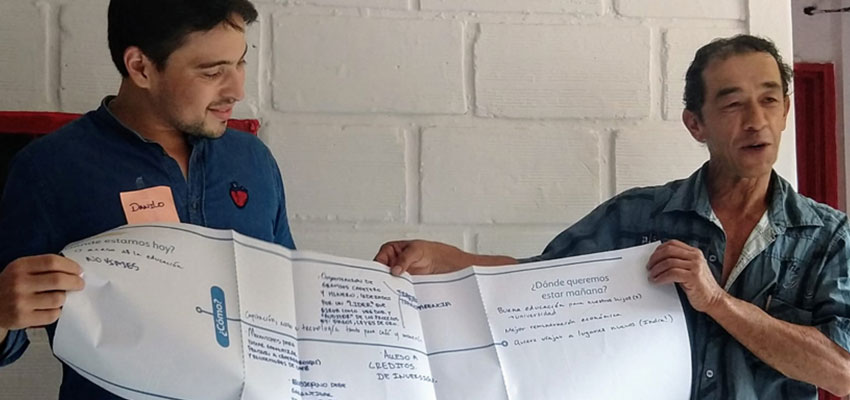
Day One: The Day Begins
We started the morning driving to the mining and coffee production community of Santa Rita to facilitate a workshop with women who were both miners and coffee field hands. These women work seasonally in both industries, and are known as chatarreras, who work with the low-yield scrap ore to extract the remainder of the gold. Women have been practicing this traditional activity for more than 400 years. In the best case scenario, the women in our target community typically can extract 460 USD per load of ore, which may variably take weeks to months to process; however, this figure is an outlier, bounded by the uncertainty of even finding gold, and tends to range much lower.

The workshop
When we arrived, we all met in a small community center, which had a total of 12 female participants and one male participant.
Two groups of students participated: D-Lab: Supply Chains students as well as D-Lab: Gender and Development students. Over the course of the semester, the Gender students worked with stakeholders from Universidad Nacional de Colombia, Medellin in order to implement a participatory needs assessment workshop.
Our first trip to Colombia was designed to be both an information gathering session for us, as well as a joyful, engaging experience for the women. We sought to answer the following questions:
- What are the aspirations and ideal lives that these women want to live, outside of legal or economic challenges?
- Who are the stakeholders in the value production, and who is controlling the capital resources of the community?
- How are power dynamics in the target community amplified by gender?
- What are the pain points in the economic and legal processes of their livelihoods where women feel they lack full agency?
The women participating have little formal education, low literacy, aren't formaly organized, and live in single-income dependent families. They were energetic, fun, and had strong networks of community. While we were there, both of the industries of the region were on hold, so the women did not have a source of income.
We started with introductions and a fun game: dos verdades y una mentira (two truths and a lie). This game allowed the participants to get creative and think abstractly, and quite a few women caught on quickly and offered deeply revealing responses:
- “I have three children, a husband, and I come from Santa Rita” -the lie: I have a husband
- “I am from Venezuela, I have two daughters, and poverty will end” -the lie: Poverty will end
After this game we started our first formal activity: El Mapeo de los Suenos (Map of Dreams).
Map of Dreams
The objective of this activity was to understand what the long term aspirations of the women of Santa Rita were; what do they dream for themselves, their children, and their community?
The women broke up into groups and wrote down their dreams on two sheets: one for themselves and one for their children.
These women wanted to be able to study and receive skills training to enter a new profession. They wanted to be able to have fun, dance, party, travel, and spend more time with their children. They were very interested in gaining credit and starting their own businesses. And although most women maintained a nihilistic view of the possibility of improvement of their own lives, they continued to maintain a positive outlook on improving the lives of their children, and their possibility of leaving Santa Rita.
“I want to live in peace with my children and myself."

Bingo Activity
The objective of this activity was to help the women identify what benefits and challenges they see in both their coffee and mining activities, and which of these benefits and “pain points” they found more relevant.
For each industry (coffee and mining), we asked the women to positively or negatively associate several aspects of their lives as they were impacted by the industry through a bingo game. We then asked them to rate the extremity of these positive or negative experiences by adding corn kernels to each bingo slot (least extreme: 1; most extreme: 4). These responses varied group to group, but following are some generalized trends.
Coffee Positives:
- Friendship they developed working with other women
- Some contribution to household income (less than mining, however)
Coffee Negatives:
- Too time demanding (little time to spend with family)
- Too physical
- Little money for a lot of effort
Mining Positives:
- Better earnings (than coffee)
- Shorter hours (day ends at middays); more time for family and children
- They feel as if this is independent work (although they are working in a vulnerable position for an administrator)
Mining Negatives:
- Criminalization of mining by the government since mines cannot use mercury, and they would be required to pay for formalization
- Physically exhausting work
- Health as a negative (however, the rating of the negative impact of mining on health was ranked low, demonstrating a lack of knowledge on the health risks evident in mining)
Journey of Experiences
This activity was designed to identify each step of the chatarreras' recuperation of gold, and to map the following pain points on a timeline.

Pain Points:
- The women have to choose among the scrap tailings left by the male miners and administrators of the mine. This step is hampered by access to quality material, as well as removal from the site by the male administrators if the source scrap material is found to contain a better percentage of gold. Furthermore, a lack of access to the correct sizing of gold in the ore causes downstream problems in processing with mercury.
- The rocks are heavy to put in the grinder, and they have long waits to access the grinders.
- In the processing stage, the women may have to wait days to get secondary access to the cocos after the miners finish, which serve as a structural impediment to their work. Furthermore, this is the main mercury intensive step, where women face disparate exposure due to the size of their ore.
- In the smelting of the ore, the men who smelt the gold don’t let women see the process, and the women believe small quantities of the gold are stolen during the blow torching process, which blows out small gold flecks.
- In the buying and selling process with vendors, women must accept whatever price is offered to them for their gold, which tends to be low. The judgment on the purity of gold is not transparent, controlled by men, and not validated externally by the women.
The entire process for artisanal mining is intensive, but the women do get a good proportion of the gold held within the small rock ore.
Pathways to Change
In the pathways to change activity, groups wrote where we were right now, and where we want to be in the future with our aspirations. Then we opened out a middle section of the pathway of change, exposing space to write the concrete steps to achieve the stated end goals. The following were some stated goals.
- Creating alternative businesses outside of coffee and mining to stabilize the level of income and reduce uncertainty.
- Increased training, capacity building, and mentoring, not just for increasing productivity in mining, but to increase capacities in other possible fields.
- Organizing to increase the women’s voice and bargaining power, and possibility for a negotiation skills workshop.
- Reducing health risks such as exposure to mercury through the use of physical protection gear and education on the risks of mining.
- Some level of social security to reduce dependence on children’s or partner’s income when they stop working--possibly through a communal fund.

Conclusion: organizing, capacity building are the first steps
Overall, we believe that organizing, capacity building, and education are the first steps to improving the quality of lives of these women, both within the system of mining as well as trying to reduce dependence on mining through diversification. Another goal is to use capital to reduce dependence on the men in the process, by possibly creating a women-run ecosystem of processing, smelting, selling, and working the gold. We also believe negotiation skills could be used to ameliorate the multiple points in the chain that leads to lower wages for women, especially the first: increasing access to better grades of ore.
Our next step is to conduct a creative capacity building workshop, as well as continue to gather more formalized data through interviews with the women. We also aim to look at economic and technical solutions to the women’s problems, such as gaining access to internationally funded microcredit loans or reducing dependence on the bottlenecks of technology that are controlled by men. This experience was overall positive for both us and the women. The women were able to let loose and enjoy themselves at multiple stages (which they expressed quite strongly!), and we were able to collect valuable information on their lives, as well as the overall process of small scale artisanal mining.


